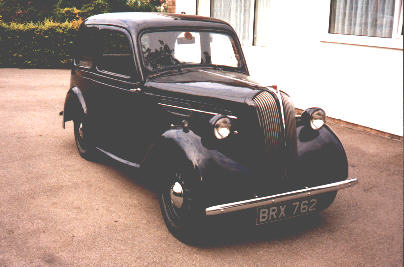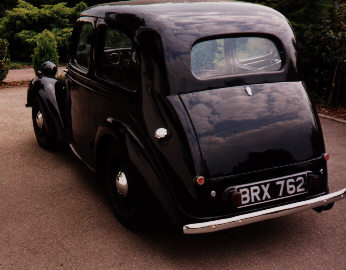FLYING 8
 When
it became obvious that the Flying 9 would be off the road for some time I looked
around for something
which we could use in the meantime.
Eventually I saw a advert
for a 1939 Flying 8 for sale in East Anglia. After much debate with my wife,
along the lines “one Standard is enough, if you buy another one, DZ has to
go”. I sort of agreed and we went
to see it. Apart from some dents in
the bonnet & roof, none of which had broken the paint surface, it was in
good original condition. It had been in the same family since new, although with a
numbers of drivers, and came with original buff log book, original registration
number, M.O.T. certificates going back to 1962 and a load of spares.
So we went off to lunch to discuss what to do next and after a test
drive, when it became obvious it was much more usable than the Flying 9, we
agreed to buy it, and a couple of weeks later we trailered it back to Raglan.
When
it became obvious that the Flying 9 would be off the road for some time I looked
around for something
which we could use in the meantime.
Eventually I saw a advert
for a 1939 Flying 8 for sale in East Anglia. After much debate with my wife,
along the lines “one Standard is enough, if you buy another one, DZ has to
go”. I sort of agreed and we went
to see it. Apart from some dents in
the bonnet & roof, none of which had broken the paint surface, it was in
good original condition. It had been in the same family since new, although with a
numbers of drivers, and came with original buff log book, original registration
number, M.O.T. certificates going back to 1962 and a load of spares.
So we went off to lunch to discuss what to do next and after a test
drive, when it became obvious it was much more usable than the Flying 9, we
agreed to buy it, and a couple of weeks later we trailered it back to Raglan.
It’s most famous claim to fame is featuring in the
March 1997 “Practical Classics” re-run of the “Birdlip Route” along with
a postwar 10, a Vanguard Phase 11 and a Vanguard
Vignale
Before the original Standard 9 was introduced in the
late 1920’s a test route was devised to demonstrate the abilities of the new
car. The route covered most of the severe hills in the Cotsworld’s, Birdlip
was the first, hence the name, followed by Cleeve Hill, Fish Hill, and
Sunrising Hill. Briefly the test was to run two cars continuously day and
night for one month, covering a set distance of 153 miles every 6 hours.
The actual running time was 5 hours 50 minutes, 10 minutes being allowed
for filling up and servicing, giving a average running speed of 26 MPH.
Fuel consumption worked out at 37/40 mpg, and a total of 18,000 miles.
Seven drivers were  employed,
each having 6 hours on and 15 hours off, with each driver
driving each car alternately, enabling him to distinguish any dropping
off of performance between the two cars. On
stripping down the cars at the end of the test, the cost of spare parts to
restore the cars to first class condition was less than £5 for the two!!
employed,
each having 6 hours on and 15 hours off, with each driver
driving each car alternately, enabling him to distinguish any dropping
off of performance between the two cars. On
stripping down the cars at the end of the test, the cost of spare parts to
restore the cars to first class condition was less than £5 for the two!!
It is true to say that the re-run was a much more
leisurely affair. It took place
over 2 days just before Christmas 1996, with a overnight stop in Gloucester,
but, despite the cold, wet, and windy weather the original route was
successfully completed.
Apart from
routine running repairs the “8” is still on the road, having covered over
6,000 miles since we purchased it.
 When
it became obvious that the Flying 9 would be off the road for some time I looked
around for something
which we could use in the meantime.
Eventually I saw a advert
for a 1939 Flying 8 for sale in East Anglia. After much debate with my wife,
along the lines “one Standard is enough, if you buy another one, DZ has to
go”. I sort of agreed and we went
to see it. Apart from some dents in
the bonnet & roof, none of which had broken the paint surface, it was in
good original condition. It had been in the same family since new, although with a
numbers of drivers, and came with original buff log book, original registration
number, M.O.T. certificates going back to 1962 and a load of spares.
So we went off to lunch to discuss what to do next and after a test
drive, when it became obvious it was much more usable than the Flying 9, we
agreed to buy it, and a couple of weeks later we trailered it back to Raglan.
When
it became obvious that the Flying 9 would be off the road for some time I looked
around for something
which we could use in the meantime.
Eventually I saw a advert
for a 1939 Flying 8 for sale in East Anglia. After much debate with my wife,
along the lines “one Standard is enough, if you buy another one, DZ has to
go”. I sort of agreed and we went
to see it. Apart from some dents in
the bonnet & roof, none of which had broken the paint surface, it was in
good original condition. It had been in the same family since new, although with a
numbers of drivers, and came with original buff log book, original registration
number, M.O.T. certificates going back to 1962 and a load of spares.
So we went off to lunch to discuss what to do next and after a test
drive, when it became obvious it was much more usable than the Flying 9, we
agreed to buy it, and a couple of weeks later we trailered it back to Raglan. employed,
each having 6 hours on and 15 hours off, with each driver
employed,
each having 6 hours on and 15 hours off, with each driver